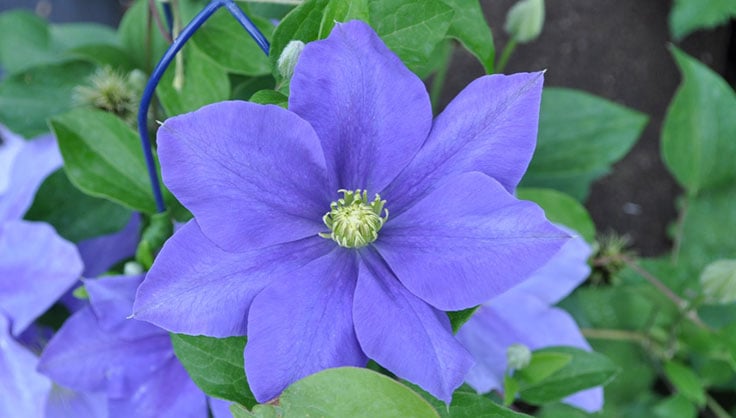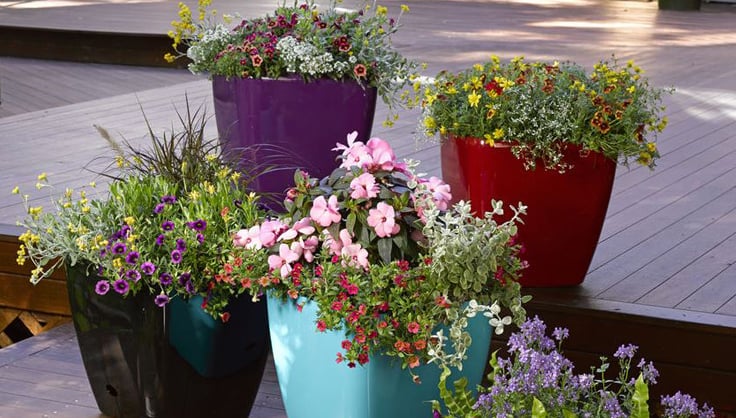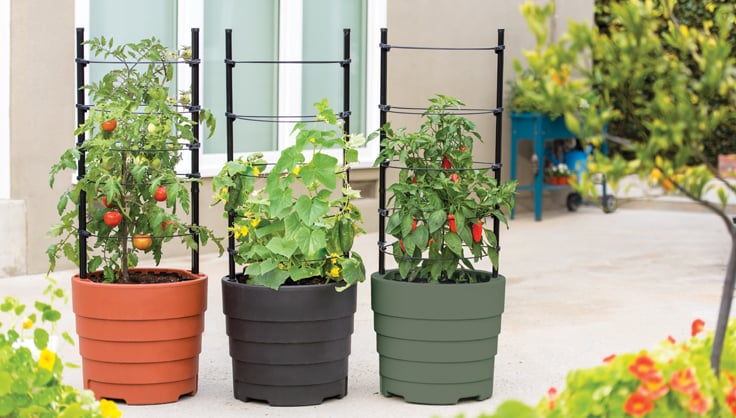Gardening on the Deck
Huge Deck Provides Canvas for Container Gardening
Jan Godsey was disheartened when she accepted that she could no longer tend her garden. Diabetic neuropathy had simply made walking, stooping and kneeling too difficult. However, after 35 years of gardening, she was not willing to give up on her passion— and neither was her family. So in 1994, they started building what she now calls her "goofy garden." And what a garden it is. On a 1,288-square-foot deck garden she has planted 40 large containers of vegetables, flowers and herbs and arranged them with rustic furniture and pieces of artwork.
Sections of the deck are separated into rooms: a living room with a rain shelter and rustic furniture, a shade garden with a log arbor, a vegetable garden and a potting shed.
"When I walk onto the deck, I'm in another country, a vacation spot, my own little paradise," she said.
Building the Goofy Garden
It started seven years ago when her "engineer-and-all-around-good-guy" husband Joe decided to build an extension off of their tiny 12-by-12-foot deck. And he dreamed big. He built a two-ton deck that ranges from four to eight feet off of the ground.
When he was done, the deck wrapped around two sides of their L-shaped house. It is 14 feet wide and 52 feet long on one side and 40 feet long on the other— more square footage than their home!
Jan designs the gardens and does most of the planting and tending of the plants. Joe does the construction projects, and their two grown daughters help out when they can.
"This has been a family project," she said. "I've been slowed down a lot. I couldn't have done it without help."
Seven Years of Experimentation
Before the deck, Jan was a vegetable gardener, growing immense yields in a 2,000 square foot garden. Gardening on the deck, she discovered, was not the same as growing on the ground. So she's been learning and experimenting ever since.
"I try something and if the results are good, I mark it down and go from there," she said. "If the results are bad, well, I've learned something."
She's grown dozens of varieties of vegetables, annuals, herbs and perennials. She even had a maple tree in a pot. It lived for seven years and grew to 17-feet tall until the roots were too big for the pot and it died.
She's had the best luck with annuals and vegetables, and she's found that these plants thrive in containers.
"It's such a clinical setting, and I can control so many variables," she said. "Everything is sooner, bigger and faster. I was done harvesting pumpkins and corn the first week of August this year. Subsequently, everything dies faster too."
The Joy of a Deck
The Godseys spend as much time as they can out on the deck. They eat meals there, read, spend time together, relax.
"It feels good to sit out there at night and listen to the robins and creatures that come up on the deck," Jan said.
She also enjoys making the deck not look like a deck.
"With grasses and tree branches I cut up the very pragmatic lines of an L-shaped deck and make it feel like you're on the ground and meandering through a garden," she said.
This is a garden that she and her family have created together. "The fact that it's still a work in progress and that all our tiny family is involved makes it even more special to me," she said.
Jan's three keys to a great container garden
- Water is key
Jan's biggest challenge is providing enough water for her container plants. The large root systems, sun and wind conspire to go through large amounts of water during the summer. "During July, I've had to water up to four times per day," she said.
Jan has learned to make sure that all of the plants in a container have the same moisture requirements. She also makes sure to check each container's water needs frequently and thoroughly. "Sticking your finger in the dirt is not enough, you need to stick your hand all the way to the bottom to feel for water," she said. - Monitor and maintain pH
Because the soil environment is so limited in containers, Jan has found that she must pay extra attention to the soil's pH level.
"I measure pH periodically and use all kinds of amendments to keep it balanced, like eggshells, coffee grounds, greensand and compost tea," she said. - Follow the pattern of the sun
On Jan's L-shaped deck each section receives a different amount of sunlight at different times of day. She plans her containers and garden rooms based on this pattern of sunlight and shade.
Last updated: 08/22/2023
Print this Article:
Related Articles
Get the Dirt
Stay up to date on new articles and advice. Please fill out the information below.



